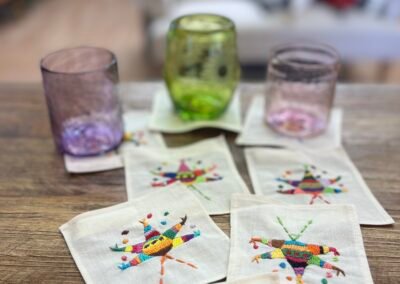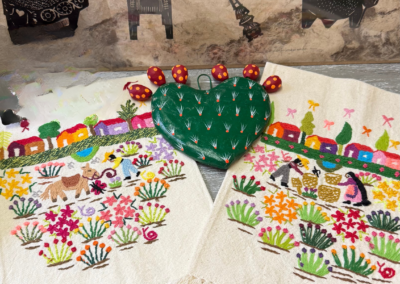Textiles & Embroidery
Textiles / Textiles
Each region in Mexico boasts its own distinctive textile style, shaped by local history, climate, and available materials. For example, Oaxaca is known for its handwoven textiles crafted on both backstrap and pedal looms. Backstrap weaving, practiced by indigenous groups like the Zapotec, Mixtec, Mayan, and Nahuatl, uses a portable loom attached to the weaver’s body, allowing for traditional patterns and techniques. Pedal weaving, or foot-treadle weaving, involves a larger loom operated by foot, which enables the creation of more complex and detailed patterns and is commonly used in Oaxaca, Jalisco, and Puebla. Artisans use materials such as cotton, wool, and silk, choosing based on the textile’s purpose and desired texture. Natural dyes are also commonly used, offering a rich palette of colors that enhance the beauty and cultural significance of these traditional textiles.
Embroidery / Bordados
Embroidery in Mexico is a vibrant and expressive art form deeply rooted in the country’s cultural and indigenous traditions. Each region has its own distinct style, characterized by unique patterns, colors, and motifs that often reflect the natural surroundings, local beliefs, and daily life of the communities.
Embroidery from Tzinzuntzan/Bordados Tzinzuntzan refers to the traditional embroidery from the town of Tzinzuntzan in the state of Michoacán, Mexico. This form of embroidery reflects the artistic heritage of the Purepecha people, an indigenous group in the region; this embroidery features intricate designs with vibrant colors on black backgrounds, often depicting birds, flowers, and other elements of nature.
Otomi embroidery is a vibrant and intricate textile art form from the Otomi people of Hidalgo, Mexico. Characterized by bold, colorful designs, it often features lively depictions of flora and fauna, including birds, flowers, and animals, stitched onto natural fabrics like cotton. This embroidery technique combines vivid colors and detailed patterns, reflecting the rich cultural heritage and artistic traditions of the Otomi community. Each piece of Otomi embroidery is a unique work of art, showcasing the skill and creativity of the artisans while preserving the cultural stories and symbolism of the region.
Animalitos are made in Chiapas and often crafted from embroidered felt. These charming figures are typically handmade by indigenous artisans, particularly from the Tzotzil and Tzeltal communities. The animalitos are known for their vibrant colors and detailed embroidery, which often feature traditional patterns and motifs. Each animalito is unique, reflecting the artisan’s creativity and cultural heritage, and they are popular as decorative items, toys, or souvenirs that represent the rich artisanal traditions of Chiapas.








